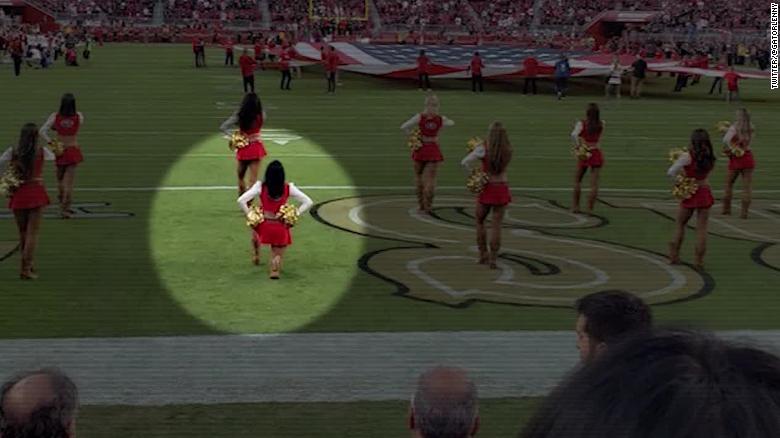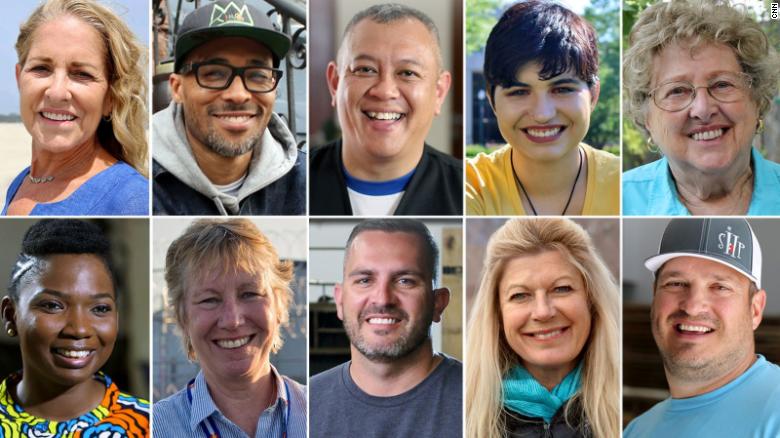Photographs by John Moore/Getty Images
Story by Ray Sanchez, CNN
A caravan of Honduran migrants moves north after crossing the border from Honduras into Guatemala on October 15.
The shirtless crying boy cowers in fear. His weeping mother desperately clutches onto him.
They’re caught between a seemingly impenetrable wall of federal police officers carrying riot shields and a surging caravan of Central American migrants on an international bridge separating Mexico and Guatemala.
The image was captured Friday by Pulitzer Prize-winning Getty photographer John Moore.
“It gets to the heart of the desperation that so many of these people feel in leaving everything behind for an extremely uncertain journey to the United States,“ said Moore, who has covered immigration on both sides of the border for the past 10 years.

A child takes cover as Mexican riot police clash with the migrant caravan on the Guatemala-Mexico border on October 19.
The latest migrant caravan formed in San Pedro Sula, Honduras, more than a week ago. It made its way through Guatemala before arriving at the Mexican border on Friday, when federal police at one point fired tear gas at an unruly throng, including some migrants who hurled stones.
“This boy and his mother were caught in the middle,” Moore said in a Facetime interview from Guatemala City.
“Whether the police should have let them through or not is a separate question. But I have to say the riot police handled the situation relatively well. They responded with very little violence.”

A member of the migrant caravan watches as a fellow migrant is searched by Guatemalan police at a highway checkpoint en route to the border with Mexico on October 18.
The tense standoff could have easily resulted in a potentially deadly stampede on the bridge. At one point, a bleeding woman lay on the ground just below where Moore was standing. The crowd surged toward the Mexican side of the bridge. Moore and others shouted at them to slow down.
UN officials estimate the numbers of migrants in the caravan at more than 7,000. It’s the largest caravan Moore has witnessed.
“It’s worth remembering that every single day thousands of people try to cross the US-Mexico border,” he said. “That’s not new. What is new is these extremely large groups of people coming all at once. That makes a visual spectacle that normally we don’t see.”

Children in the migrant caravan are lifted over a gate at the Guatemala-Mexico border on October 19.
Also remarkable is the desperation and resolve among members of the growing northern procession of people fleeing violence and poverty in Central America.
They lifted young, crying children over tall fences at the international bridge last week. A surging crowd came close to crushing a terrified woman and a boy against a phalanx of riot police lined up near a sign that read, “Bienvenidos a Mexico,” or “Welcome to Mexico.”
“It’s amazing to hear the determination they have,” Moore said. ”They have very bleak opportunities in their home countries and they see no down side in their struggle to reach the United States. Many feel they have nothing to lose.”

Guatemalan Red Cross medics treat a migrant who collapsed from heat exhaustion while walking with the caravan near Quezaltepeque, Guatemala, on October 16.
US President Donald Trump has vowed to declare a "national emergency" over the approaching caravan and others like it, threatening to slash foreign aid to several Central American countries and claiming that criminals — and specifically people from the Middle East — had infiltrated the group. Analysts and senior counterterrorism officials refuted that claim, and CNN reporters following the caravan say they haven’t met anyone from the Middle East.
Still, the migrants seem undeterred by the rhetoric.
“What’s on their minds is the desperation they feel in their own countries,” Moore said. “They look at the realities they face back home and that’s much more on their minds than what Donald Trump may or may not be saying. Many of these people know that what the American President says and what he does are not always the same thing.”

Migrants wade across the Suchiate River while crossing the border from Guatemala into Mexico on October 20.
Moore has covered many international crises, including the Ebola epidemic and the Arab Spring. And in more recent years he has focused on the US-Mexico border.
He has traveled to Mexico, Honduras and Guatemala and accompanied migrants at the start of their journeys north. He has also had access to federal agents and joined them during patrols along the border.
The experiences are part of his book “Undocumented: Immigration and the Militarization of the United States-Mexico Border.”

Migrants cross the Guatemala-Mexico border in rafts on October 20.
He marvels at this latest unrelenting wave of humanity.
“They have an energy which seems boundless to move in one direction and that’s north,” Moore said.
There is a solemnity in Moore’s photo of a young man staring down and forging ahead with a crowd trekking north after crossing the border from Honduras to Guatemala on October 15.
“It’s not a small thing to pick up your family and move thousands of miles on short notice,” he said.

Families rest for the night in a community gym on October 16 in Chiquimula, Guatemala.
Another image captures a migrant’s free fall from an international bridge between Mexico and Guatemala. A group of men looked up from the shallow, muddy river, their arms raised as if preparing to catch him.
“I can’t see what the Mexican authorities can do to stop the caravan without using extraordinary violence and hopefully that won’t be the case,” Moore said.
Some migrants have packed onto makeshift rafts to be ferried across the Suchiate River to the Mexican side. Others wade across the chest-high waters.

A migrant jumps off a bridge between Mexico and Guatemala on October 20.
“They’re tough people and they can stand a lot,” Moore said. “They wake up at 4 a.m. and are often on the road by 4:30 or 5 in the morning. They cross great distances both walking and hitchhiking in a short period of time. The tropical heat in southern Mexico is absolutely oppressive and still they manage to move forward. It’s extraordinary to see.”
Along the way, ordinary Guatemalans and Mexicans have donated food, water and clothing. Some rest on streets outside overcrowded migrant shelters.
“If they’ve faced meanness, so far I have not seen much of it,” Moore said. “But this journey is far from over.“

Honduran migrants move north on October 16 near Quezaltepeque, Guatemala.
John Moore is a Getty Images photographer based in New York. He has spent the past 10 years covering the immigration issue from both sides of the US-Mexico border. Follow him on Instagram and Twitter.
Photo editors: Clint Alwahab, Brett Roegiers and Bernadette Tuazon
Photo editors: Clint Alwahab, Brett Roegiers and Bernadette Tuazon

















![[Photos] Celebrity Chef Scandals You Need To Know About [Photos] Celebrity Chef Scandals You Need To Know About](https://images.outbrainimg.com/transform/v3/eyJpdSI6IjY5M2NlOWE3MDE2NGY3NGE0OGYyMDQ4NjI3MmQ4MDQyYTEzNjhiN2M1ODAyNGNhZDhjOWI4ZTVhZTI4ZWQxM2MiLCJ3IjozNTAsImgiOjE4NSwiZCI6MS41LCJjcyI6MCwiZiI6MH0.jpg)










Our mission is provide $50-$150 affordable gorgeous flashy ring, regardless of your form, color or size.
ReplyDelete